What is a paring knife?
Knives deliver powerful cuts, but they can also be used for dainty and detailed work in the kitchen. Chefs use a wide variety of knives to achieve different purposes. One knife among them that every chef carries is a paring knife. It can be called the baby of the knife family due to its size. Many people call the paring knife a small miniature version of a chef's knife that is used for intricate and detailed work.
The paring knife has a small blade that measures between 2 ½ to 4 inches long. It is smaller in size and can be used for a variety of purposes.
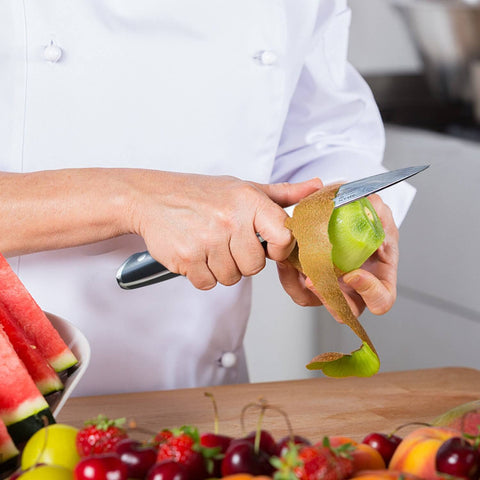
The importance of paring knife
A paring knife is ideal for when subtle touches and cuts are required. It can't and should never be used for hardcore work. There are other knives for that purpose. So, what is a paring knife used for? Well, it can be used to devein a shrimp, cutting, and peeling small vegetables like garlic. It can handle quite some tasks to peel garlic with a chef's knife. So, that is where the paring knife comes in handy.
It is by all majors the smallest knife found in the kitchen. However, don't let its size fool you. Its vital importance lies in doing the delicate and detailed work that larger knives can't perform. They're also ideal for deseeding small fruits and mincing small items like garlic or dried herbs.
One significant importance of the paring knife is its multi-purpose usage. IT can be used for so many things, from coring to peeling and segmenting to decasing. You can practically peel a whole fruit or vegetable in one go with a paring knife. Its sharpened blade will do all the work, and you will just have to maintain a slight cutting angle and your thumb on the blade.
It can be used either by holding the fruit or vegetable in hand or on the cutting board. The small size of the knife allows ample room for control and cut. Hence, minimizing the risk of cuts that can happen with a big blade.
What is the difference between a paring knife and a chef's knife?
A paring knife is a small and miniature version of a chef's knife. However, it serves different purposes and is used for different kitchen items than a chef knife. The first difference is in appearance. A paring knife has a small blade between 2 ½ to 4 inches, whereas a chef's knife is bigger in size.
There is an intended use of each blade, size, and shape when it comes to knives. The narrow blade with small size makes the paring knife ideal for peeling small fruit, deseeding, coring apples, and other delicate work. The chef's knife comes with a curved blade that makes it easy to roll forward and backward on the cutting board. A chef's knife is the ideal tool for chopping and dicing a wide variety of vegetables or even meat side by side. It can be used for pretty much anything except for dainty and detailed tasks with small items.
What types of paring knives are there?
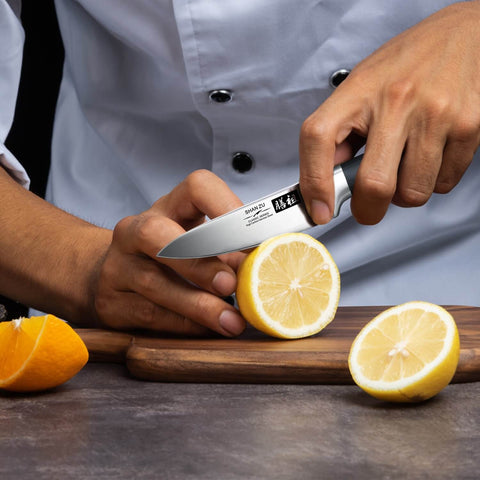
Spearpoint/ spear tip paring knife
The spear point knife is known as the classic paring knife. It has a short and outwardly curved blade. In the words of chef Gordon Ramsay, this outwardly curved blade allows the knife to do the work. All that is required from the user is correct holding and gentle pressure on the blade. This way, the knife does all the work without too much pressure exertion from the chef. So, it is critical to use a light hand when using a spear tip paring knife.
The spear tip paring knife is mostly used for coring fruits and vegetables. Additionally, it is also used for peeling and slicing. All in all, it is quite a multi-purpose knife with high functionality.
Bird's beak paring knife
As the name suggests, the bird beak paring knife comes with a sharp tip and concave sickle-shaped blade. Have you ever seen fancy salads with fruits and vegetables cut like art? Well, this knife is one of the main champions behind that delicate and detailed work. Aside from that, it is also used for trimming, peeling, and coring fruits and vegetables. One of the most cherished advantages of a bird's beak paring knife is the rounded blade that reduces waste while peeling.
Sheep's foot paring knife
Sheep's foot paring knife is ideal for julienne cutting. The blade is straight with a rounded tip. So, only the main point of the blade will touch the board during chopping. Hence, making it easier to achieve uniform thinly sliced vegetables of herbs. The sheep's foot paring knife stays sharp for a long period of time and can also be used to cut soft and hard cheese. A disadvantage with this knife is that it lacks the sharpness that is present in the other style of paring knives.
Western-style Japanese paring knife
The western-style Japanese paring knife has a spear-like shape and a less-curved blade. It can be best utilized with garnishing, intricate cutting, and carving as the knife's shape allows for better grip and control of the life. On the downside, this knife is quite expensive and has a razor-sharp touch.
Serrated blade paring knife
The serrated blade paring knife has a sawing motion that makes it easier to slice through the tough skin of citrus fruits without damaging the flesh. So, you can slice tomatoes of any size as per your liking. Additionally, the serrated blade paring knife is ideal for trimming cake edges and evenly slicing chilled dough.
How to hold a paring knife?
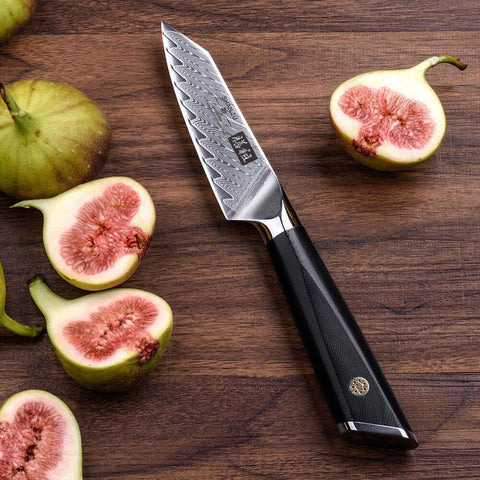
The correct kind of grip is critical to hold the paring knife and utilize it to its full potential. A firm grip will help in having a complete hold of the blade. Paring knives are small and designed in a manner to fit the human hand easily. So, whether you're holding the knife and using it in the air to peel or cut or using it on a cutting board – a good well-directed grip is key. Ideally, you should use 3 or 4 fingers on the knife handle and leave your thumb free to rest on the cutting item.
Moreover, the knife should be held in a manner that the pointy end of the blade should be directed towards you and not away from you. Make sure to have total control of the blade so that you can move the knife according to your need.
What are you using a paring knife for?
Many people ask what a paring knife is used for, and the answer is way too many things. Let's look at some of the most popular uses of paring knives.
Coring and peeling tomatoes
Coring tomatoes can be done easily with a sharp paring knife. Just insert the sharp tip of the paring knife into the core. Insert it for about one inch and at a slight angle. Run the blade through the whole core using a sawing motion. You will achieve a conical cut and can pop the core out easily.
The paring knife can also be used to make X shape cut into the bottom of tomatoes for boiling. Once you have boiled them, just use the cuts to peel of skin starting from the X.
Deveining shrimp
Use the paring knife to make a shallow cut on the back of the shrimp. It will expose the vein. Now, you can use the pointed tip of the knife to take the vein out. Deveining is most easy with the paring knife and can be done within a minute.
Thinly sliced garlic
The paring knife is ideal for slicing delicate and small items like garlic. All you need to do is stick the end of the blade into the clove and twist the knife.Once the knife is twisted, so will be the clove, and you can get all the peel off in a go. Now, wrap your fingers around the handle of the knife and have a secure grip. Your thumb should be against the blade, and your hand should be in a claw motion to evenly slice the garlic.
A pro tip: Hold the garlic in a way that your middle finger is in front, and the rest are beside. It will ensure the safety of your hands while slicing.
Prepare Brussels sprouts
Use your paring knife to cut the stem end of all the sprouts. Now, place the sprout on the cutting board and use your paring knife to cut the sprout in half.
Prepare Bell peppers
Use your paring knife to cut and remove the top, bottom, and seeds from the bell pepper. Make sure you also remove the stem nicely. Now, lay the pepper skin side down flat on the surface and cut into either strips or chopped pepper as per your requirement.
Prepare fennel
Use your knife to remove stalk and feathery background. Additionally, inspect the fennel and remove any hard or blemished outer layer. Now, cut the fennel in half, starting from the base. And then, use your knife to remove the pyramid-shaped cone.
Spareribs for the Grill
Use your knife to thinly remove the membrane from the underside of the ribs. Now, lose the membrane edge of the rib with your knife. The membrane is slippery in nature. So, use a paper towel to hold it firmly and pull slowly. The whole membrane will come off in one piece.
Loosen a Cheesecake for Easy Release
Once the cheesecake has sufficiently cold down, around 5-10 minutes, use your knife and run it onto the sides of the pan. It will release the cake easily. Cool down the cake until it's barely warm, and then tightly cling wrap and refrigerate it. Once it's firmly set, it will easily come out of the molding without breakdown.
Peeling ingredients
The trick is to hold the knife in your hand while peeling to get the thinnest strip of skin without wasting any flesh. Your fingers should wrap firmly around the blade, and your thumb should guide the peel. Little pressure is required, and the blade needs just a little nudge from the thumb to do its job.
Decasing sausage
Sausages have small sheaths around them to keep the ingredients in one place. A paring knife is an ideal tool to get rid of that thin skin easily. You're your knife to draw a line vertically on the sausage. Keep minimal pressure to ensure that the cut isn't deep. Once you have achieved the cut, simply peel and get rid of the skin.
Hulling strawberries
The hulling strawberry process is very much like taking the top off the tomato off. Just insert your paring knife to make a small incision. Run the blade to get a conical cut and remove the circle out.
Scoring meat
Often meats have fatty pockets that do wonders for the flavor while cooking. However, many people want them removed after cooking. A paring knife is the best tool to get those fatty pockets off the meat. Use your paring knife to draw lines over the fatty section and then pull it out.
Segmenting the Citrus Fruits
The best way to segment fruits is by placing them on a flat surface and using the knife to slice them downward. This way, you can remove the peel along with the pith in long strips. Next, use the sharpened tip to segment the citrus fruit easily.
Things you shouldn't do with a paring knife
Paring knives are ideal for delicate, detailed, and intricate usage. They aren't manufactured with big tasks like slicing meat or cutting through bones. Attempting such things with the paring knife can damage the blade of the knife.Needless to say, but you won't get the required results as well.
It is ideal for small vegetables or herbs. Hence, it also shouldn't be used for cutting hard vegetables or fruits like cabbages or cauliflower.
What to look for when buying a paring knife
The material
First things first, the material should be considered when buying a paring knife. The most popular blade material these days are stainless steel and carbon steel. Stainless steel is a better option as it has less rusting during use. Typically, look for rust-resistant, anti-fading, and enamel coating for optimal use.
The Handle
A good handle is critical in getting the best use out of the blade. So, pick a handle that can offer balance and a comfortable grip. There are several designs in the market that can help in increasing friction and ensuring a firm grip with the anti-slip feature.
The Blade
Look for blades with higher sharpness as they will make the cutting process easy, sharp, and quick.
The Construction
The screws holding the blade to the handle should be installed securely. If you observe loose screws or screws that can potentially get loose within a few uses, don't pick the knife.
Comfortable grip
A comfortable grip goes a long way in maximal use of the knife while ensuring the holding hand isn't facing discomfort or pain. Hold the knife in hand to assess the comfort and then decide accordingly.
SHANZU great paring knife options
It is best to trust a reputed manufacturer for paring knives. SHANZU offers a good variety of paring knives along with a wall knife holder . So, take a look and pick the knife that best suits your need. You will never have to worry about the quality of the material, as every knife offers premium quality and functionality.
How to care for a paring knife
A maintained and clean paring knife will last you longer while giving you true value for your money. So, look at these few tips to care for your knife and extend its lifeline.
Cleaning the knife
You should know that paring knives aren't dishwasher safe. The environment within the dishwasher can be harsh for them and will impact the blade. These knives have delicate blades. So, the best option is to wash these knives in the sink to prevent any damage.
Storing the knife
Don't ever randomly throw your paring knife into a kitchen drawer. It can be dangerous and may result in cuts. Ideally, the knives should be stored in a knife holder for safety as well as maintenance purposes.
Sharpening the knife
Household sharpening tools can seem like the ideal solution. However, these can be abrasive and damage the knife instead of sharpening it. So, the best way is to trust a knife expert for sharpening your paring knife.
So, whether you're looking for the ideal tool to deseed and trim your vegetables in a creative manner or for something to help with ln loosening a cheesecake, a paring knife will be your best. Its compact size and variety of uses make it ideal and a compulsory item for every kitchen. So, accomplish your minor and detailed work in the kitchen with a paring knife. Meanwhile, don't forget to utilize the proper etiquettes of buying and caring for a paring knife. It will last longer, and you will be proud of your maintenance skills. It's a win-win.
Invest in quality knives and make the time you spend in the kitchen your happy time with smart kitchen tools!

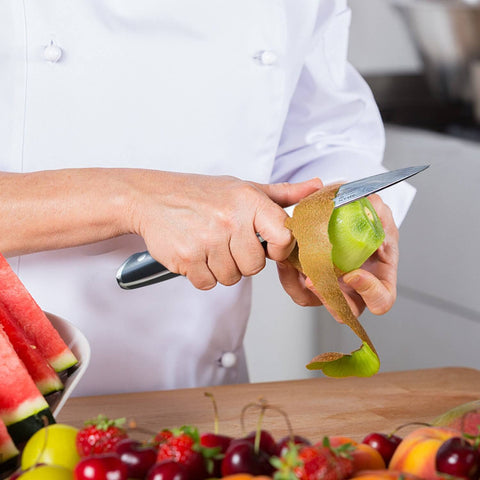

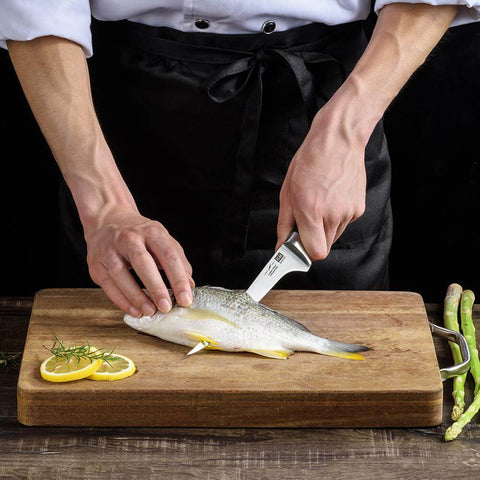

Comments (0)
There are no comments for this article. Be the first to leave a message!